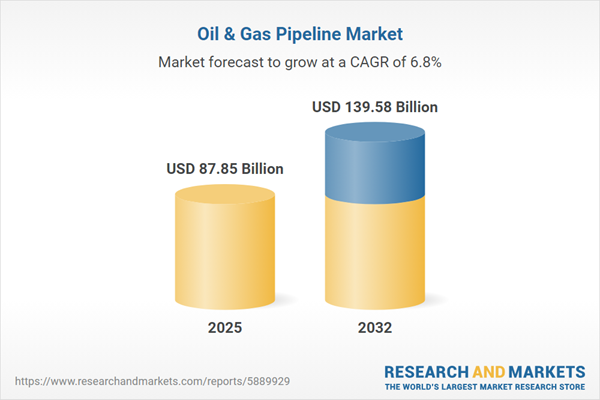Speak directly to the analyst to clarify any post sales queries you may have.
The oil and gas pipeline market is undergoing strategic transformation as organizations prioritize digital solutions, regulatory compliance, and operational strength to ensure efficient future energy delivery. Leaders are aligning investments with technology and compliance, establishing a dynamic environment for global energy infrastructure.
Market Snapshot: Oil and Gas Pipeline Market Growth and Dynamics
The oil and gas pipeline market is reporting steady growth, propelled by continued infrastructure investment and an increased emphasis on efficient energy transport solutions. Organizations are modernizing asset portfolios, making real-time monitoring and automation standard industry practice. Regulatory requirements are rising and shaping new operational standards, while regional variation in digital adoption adds further complexity. Staying agile and optimizing technology deployment are essential as partnerships and stakeholder oversight evolve, ensuring competitiveness within a changing market.
Scope & Segmentation of the Oil and Gas Pipeline Market
- Material Types: High-density polyethylene, polypropylene, alloy steel, carbon steel, stainless steel, and reinforced concrete each contribute specific regulatory and operational advantages, supporting infrastructure resilience in diverse environments.
- Fluid Types: Solutions are tailored for the transport of crude oil, natural gas, and refined petroleum products, with each requiring particular safety protocols, advanced flow systems, and protective coating specifications to address fluid properties.
- Transportation Types: Distribution, flowline, gathering, and transmission pipelines integrate energy delivery from production to end-user, streamlining supply across each stage of the value chain.
- Pipe Types: Seamless and welded (including electric resistance welded and submerged arc welded) pipes are selected based on pressure management needs and regional site conditions, supporting a broad range of project requirements.
- Diameter Segments: Categorization by diameter—up to 16 inches, 16–24 inches, and over 24 inches—enables precise planning for capacity and infrastructure expansion, directly influencing operational flexibility.
- Pressure Ratings: High, medium, and low-pressure pipelines are engineered for safe, extended transport, employing specific wall thickness and protective measures to manage operational risk over time.
- Coating Types: Fusion bonded epoxy, polyethylene, and reinforced concrete coatings protect against environmental and mechanical stresses, enhancing pipeline longevity and compliance with regulatory standards.
- End Use: Distinct approaches for onshore and offshore pipelines address varying engineering and environmental challenges, adapting logistical support and regulatory strategies accordingly.
- Regional Analysis: The Americas, Europe, Middle East, Africa, and Asia-Pacific present diverse regulatory frameworks, infrastructure maturity, and technology adoption rates, driving strategic priorities for investment and advancement.
- Key Companies: Leading participants such as Enbridge Inc., Enterprise Products Partners L.P., Energy Transfer LP, Kinder Morgan, TC Energy Corporation, The Williams Companies, ONEOK, Plains All American Pipeline, MPLX LP, and Magellan Midstream Partners shape industry benchmarks and influence supplier relationships and digital transformation initiatives.
Key Takeaways for Senior Decision-Makers
- Resilient supply chains support reliable project delivery and help organizations adapt during market shifts and disruptions by diversifying sourcing and operational planning.
- The adoption of digital twin and predictive monitoring technologies is redefining asset maintenance, optimizing uptime and contributing to operational sustainability.
- Close coordination between engineering, procurement, and IT functions streamlines compliance, enhances project performance, and facilitates seamless project deliveries.
- Strategic infrastructure upgrades facilitate the integration of low-carbon fuels and biofuels, futureproofing portfolios against evolving regulatory landscapes.
- Monitoring changing regulations and employing effective project management improves risk controls and supports robust project execution at all stages.
- Advancing workforce digital skills strengthens process automation, supports ongoing improvement, and heightens the ability to compete in a more digital operational environment.
Tariff Impact on Pipeline Supply Chains
Recent tariffs on steel and pipeline components in the United States are increasing complexity in global supply chains. Organizations are mitigating risk by expanding supplier networks and emphasizing local sourcing to help control pricing and bolster supply predictability in an evolving regulatory climate.
Methodology & Data Sources
This analysis consolidates insights from executive interviews, engineering expertise, and regulatory reviews across both developed and emerging markets. Verification draws on technical publications, official records, field operation reports, and standards reviews, with expert panel validation to ensure regulatory and technical consistency.
Why This Report Matters
- Empowers senior leaders to proactively assess supply chain risk, prepare for regulatory shifts, and benchmark progress in digital transformation within pipeline management.
- Supplies clear recommendations for investment in materials, digitalization, and infrastructure upgrades, reinforcing agility and building readiness for future market changes.
- Delivers actionable guidance to enhance compliance, operational outcomes, and competitive positioning in a dynamic global sector.
Conclusion
The oil and gas pipeline industry’s outlook depends on advanced digital adoption, robust sourcing strategies, and continuous workforce upskilling. Focusing on adaptability and strong compliance practices will support long-term organizational strength amid ongoing industry change.
Additional Product Information:
- Purchase of this report includes 1 year online access with quarterly updates.
- This report can be updated on request. Please contact our Customer Experience team using the Ask a Question widget on our website.
Table of Contents
3. Executive Summary
4. Market Overview
7. Cumulative Impact of Artificial Intelligence 2025
Companies Mentioned
The companies profiled in this Oil & Gas Pipeline market report include:- Enbridge Inc.
- Enterprise Products Partners L.P.
- Energy Transfer LP
- Kinder Morgan, Inc.
- TC Energy Corporation
- The Williams Companies, Inc.
- ONEOK, Inc.
- Plains All American Pipeline, L.P.
- MPLX LP
- Magellan Midstream Partners, L.P.
Table Information
| Report Attribute | Details |
|---|---|
| No. of Pages | 199 |
| Published | November 2025 |
| Forecast Period | 2025 - 2032 |
| Estimated Market Value ( USD | $ 87.85 Billion |
| Forecasted Market Value ( USD | $ 139.58 Billion |
| Compound Annual Growth Rate | 6.8% |
| Regions Covered | Global |
| No. of Companies Mentioned | 11 |









